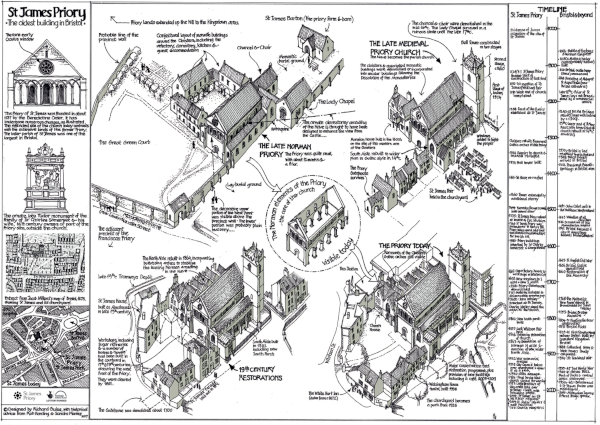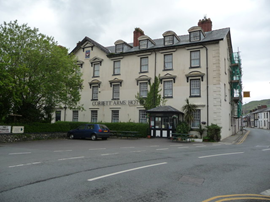St James's Priory, Bristol
The remains of St James’s Priory constitute Bristol’s oldest building in everyday use. Surviving as a parish church until 1984, major structural works and a new function have brought it back to life.

|
| The stages of the development of St James’s Priory (Drawing by Richard Guise, Context 4D, Bristol). |
Situated just to the north of Broadmead, Bristol’s post-war shopping centre, St James’s Priory is almost completely hemmed in by commercial properties and the bus station. Sadly, many visitors and Bristolians alike pass by the building completely unaware of its Grade I listed status, and its special qualities and significance to the history of the city.
The church and the adjoining Church House are remnants of St James’s Priory, founded by Robert Earl of Gloucester in 1129 [1]. The monastery probably consisted of a cruciform church with a central crossing that divided the monastic church from that of the laity. There is also evidence of cloisters, bell tower, refectory, chapter house, parlour, dormitory and other outbuildings. [2] The monastery was surrendered to the crown in 1540 at the time of the dissolution of the monasteries, but the abbot of Tewkesbury, perhaps foreseeing the coming desecration of monastic buildings under Henry VIII, had already leased most of its lands and properties to a wealthy landowner. This saved some of the original buildings, as they were converted into a mansion, but others were probably demolished. The western arm of the cruciform building was saved and became the parish church, a role it fulfilled until it was decommissioned in 1984.
St James’s then suffered almost 10 years of neglect. Pigeons, with their particularly unpleasant habits, were the only residents; damp and decay were present throughout; and the roof leaked badly. It is surprising that a group of Benedictine monks, the Little Brothers of Nazareth, agreed to lease the building from the Anglican Church in 1991 for use as a drop-in centre for homeless people in the city. The neglected church, although cold and damp, was the best option at the time. Some temporary works were undertaken to reduce water ingress. Decay of this significant historic building, although not halted, was warded off for a few more years. This date can be seen as a turning point for the building: from then on there was somebody to care about it.
Nevertheless, the need for maintenance and repair soon became critical and in 2004 the building was placed on the English Heritage at-risk register. The St James’s Priory Project, providing support for people with addictions, had emerged from the monks’ original attempts to help homeless people. Better facilities, including meeting rooms, were needed. A successful bid to the Heritage Lottery Fund followed. The architects Ferguson Mann undertook preliminary work on the bid, and Keystone Historic Building Consultants produced a conservation management plan [3] that explained the history and significance of the building. Ultimately, work costing £3.8 million was undertaken. The professional input was of great value, but the work would not have happened without the tireless efforts of the St James’s Priory Project director, Susan Jotcham, and huge amounts of passionate voluntary effort, not least by Rob Harding.
The award of funds enabled structural work to be done. The failing roof timbers were pushing the walls outwards, causing major water ingress. The outward lean of the west elevation and the internal colonnades needed foundation underpinning, but reports by Momentum Engineering concluded that there was no danger of collapse. Dendrochronological analysis of the roof timbers revealed that the structure of the wagon roof in the chancel dated from around 1346, and that of the nave from between 1411 and 1436. Considerable work was needed to stabilise the roof and protect these ancient timbers.
Once the major structural works had been carried out, it was possible to look at some of the more detailed aspects of stonework conservation and the restoration of the 56 significant monuments. A detailed report by Odgers Conservation Consultants advised on how to stabilise the west front, oculus and blind arcades, and correct past, poor-quality restoration, without losing the essential qualities of the decorative features. Very delicate work had to be undertaken to achieve this in a thoughtful and careful way as the stonework was badly eroded and had been repaired in the past with little understanding of its significance. It was important to ensure that new work was sensitively inserted and that no attempt was made to age the stone artificially. The monuments inside the church and in the adjacent Church House were cleaned of the thick brown Victorian varnish that had obscured both colour and detail, and the same care was taken to respect past work without resorting to artifice. There were some amazing transformations.
One significant matter was how make the building’s main use economically viable. After exploring a range of possibilities, the decision was taken to create a new cafe with a frontage to a busy pedestrian route to the bus station. A series of meeting rooms were created for the St James’s Priory Projects to use in supporting people in recovery from addictions, and they could also be available for rent by the many local businesses in the area. Good practice in considering how to alter and extend this listed building to provide these facilities led to the conversion of the Victorian north aisle of the church. This, the least desirable part of the building, had been roundly condemned by George Gilbert Scott and JL Pearson when it was built in 1864. Indeed, the separation of this aisle from the main body of the church could be said to have restored, at least to some degree, the original proportions of the ancient building. The simple elegance of the church following the completion of the work in 2011 demonstrates that this decision was well judged.
Part of the original Heritage Lottery-funded project was to improve public interpretation of the building and ensure that people had good access. While this was achieved to some extent in 2015, it was decided to undertake a further project to open the building up to the public more effectively. This included work to explain the building, organising events to bring people into the church, arranging guided tours of the building, and preparing leaflets and drawings to explain the building and the monuments. Work continues to make sure that Bristolians and visitors to Bristol alike know the building and come to value it.
Despite these efforts, the building remains under threat. Maintaining its economic viability is a challenge. New food outlets opposite the cafe mean that the financial environment is extremely competitive. Bookings of the meeting rooms remain strong and are helping to keep the St James’s Priory Project just about afloat, but this leaves little money for maintenance. Ferguson Mann produced a phased maintenance plan as part of the HLF documentation, but so far it has not been possible to fulfill all its recommendations.
The lack of maintenance is the first of three significant challenges faced today by this important building. A second threat relates to proposals for the development of nearby buildings. Alterations and extensions at the Bristol Royal Infirmary, close to St James’s Priory, have resulted in the release of the old hospital building to the open market. Unite, a developer that concentrates on providing student accommodation, wants to convert the existing buildings, but it also proposes a 20-storey block of student flats.
Bristol City Council refused permission on the grounds of inappropriate height, scale and massing, poor design quality and the overbearing impact of the proposed building on the amenity of St James’s Priory. The applicant lodged an appeal, but the matter is now on hold because of a recent decision by Historic England to list part of the old hospital buildings, including the chapel. It is clear that the pressure for commercial development in the area is unlikely to disappear. While it is true that St James’s Priory is already hemmed in by commercial development and that new buildings nearby have already overshadowed the smaller scale of the courtyard, it could become much worse.
A final challenge is to find successors to the individuals who put their hearts and souls into the work of saving and restoring the building. The personal characteristics of the members of the St James’s Priory Project team who worked to establish a place to provide support for people struggling with addictions have been applied also to the building itself. The result is a haven in a busy commercial area of the city that is appreciated by many, including office workers, shoppers and visitors to the nearby hospital. It is to be hoped that new champions will emerge.
This article originally appeared as ‘Saving St James’s Priory’ in IHBC’s Context 153, published in March 2018. It was written by Sandra Manley, visiting research fellow in the faculty of environment and technology, UWE, Bristol.
References:
- [1] For a fuller account of the history of the building see Manley, S, ‘Saving St James’s Priory’, in Transactions of the Ancient Monuments Society, 2015, Volume 59, pp109–134.
- [2] R Jackson, Excavations at St James’s Priory, Bristol, Oxbow Books, 2006.
- [3] Keystone Historic Building Consultants, ‘St James’s Priory, Bristol: Conservation Management Plan’(unpublished) 2006.
--Institute of Historic Building Conservation
Find out more
Related articles on Designing Buildings Wiki
IHBC NewsBlog
Images from inside a Grade II listed hotel show the scale of its collapse
The Corbett Arms in Tywyn has fallen into serious disrepair.
Old Sarum fire in listed (& disputed) WW1 Hangar - Wiltshire Council has sought legal advice after fire engulfed a listed First World War hangar that was embroiled in a lengthy planning dispute.
UK Antarctic Heritage Trust launches ‘Virtual Visit’ website area
The Trust calls on people to 'Immerse yourself in our heritage – Making Antarctica Accessible'
Southend Council pledge to force Kursaal owners to maintain building
The Council has pledged to use ‘every tool in the toolbox’ if urgent repairs are not carried out.
HE’s Research Magazine publishes a major study of the heritage of England’s suburbs
The article traces the long evolution of an internal programme to research 200 years of suburban growth
IHBC Context 183 Wellbeing and Heritage published
The issue explores issues at the intersection of heritage and wellbeing.
SAVE celebrates 50 years of campaigning 1975-2025
SAVE Britain’s Heritage has announced events across the country to celebrate bringing new life to remarkable buildings.
IHBC Annual School 2025 - Shrewsbury 12-14 June
Themed Heritage in Context – Value: Plan: Change, join in-person or online.
200th Anniversary Celebration of the Modern Railway Planned
The Stockton & Darlington Railway opened on September 27, 1825.
Competence Framework Launched for Sustainability in the Built Environment
The Construction Industry Council (CIC) and the Edge have jointly published the framework.














